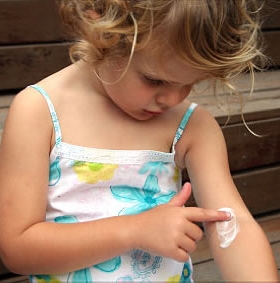Article at a Glance
In the spring—before the summer heat starts to kick in—it can be easy to forget the sunscreen. Many people think that if they can’t feel the heat of the sun that it isn’t doing any damage. But it doesn’t have to be hot for your skin to be affected by UV rays. Anybody who has gone skiing without sunscreen on can tell you that.
Doctors see a lot of serious sunburns this time of year because it is warm enough for people to spend more time outdoors, but it isn’t hot enough for them to think about sunscreen. And even though the sun may “feel” less damaging in the spring, in North America the UV rays from sunlight are actually greater during the late spring and early summer months. Even when it is cloudy outside, we still get over 70 percent UV exposure.
Many people don’t realize the damage that UV exposure can do because the results are often seen years later. But it only takes one bad sunburn to double your risk of developing skin cancer. And even if your child does not burn, sun damage can accumulate over time with day-to-day exposure. Skin cancer is the most common form of cancer in the United States, and one in five people will be diagnosed with skin cancer over their lifetime.
Before you head outdoors with your kids, here are a few things you should know.
The 411 on Sunscreen
Look for a sunscreen with a SPF of 30 and that is broad spectrum—meaning it protects against both UVA and UVB rays. Your sunscreen should also include zinc oxide and/or titanium dioxide as the active ingredients and it should be PABA and fragrance free.
Avoid spray-on sunscreens. They can get in your child’s eyes or be inhaled. Reapply sunscreen every two to three hours or after your child has been sweating or swimming. Be sure to check your sunscreen’s expiration date. Sunscreen typically only lasts two to three years.
How to Apply Sunscreen
The most common mistake parents make is not applying enough sunscreen. And it isn’t any surprise—we all know how hard it is to get sunscreen onto your kids! Luckily there are some things you can do to make live easier on yourself.
Sunscreen and Infants
Babies are particularly vulnerable to the sun’s rays and can burn in as little to ten minutes. However, babies under six months should not use sunscreen. Your best bet is to keep them in the shade or under a canopy. Dress babies in loose fitting long pants and long-sleeved shirts. Find a hat with a wide brim that protects the neck and ears. Babies are also more likely to become overheated or dehydrated, so be aware of the temperature and provide plenty of breast milk or formula.
If you baby is old enough for sunscreen, first test it on a small spot on the arm and wait for 20 minutes to make sure your child’s skin isn’t sensitive to it. If your baby doesn’t like the feel of the cold lotion, warm it up by squeezing it onto your hand first. Start with your baby’s toes first and slowly work your way up, making sure you get sunscreen into all the creases.
Other Ways to Protect Your Child From the Sun
There are several things you can do to protect your child from the sun while still having fun outside:
How to Treat a Sunburn
For additional information on how to treat a sunburn, visit our section on treating sunburns or call your pediatrician.
